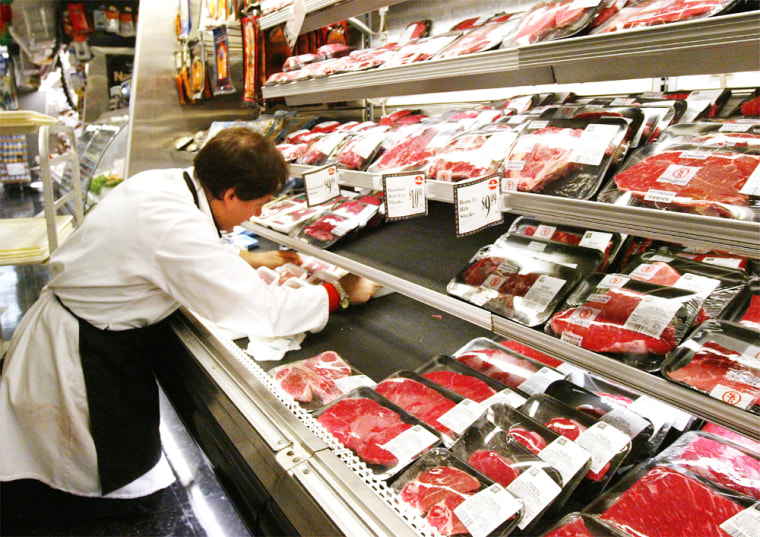Authorities said Monday they are looking for links between the Holstein infected with mad cow disease and a Canadian cow that was diagnosed with the deadly illness in May.
Repeating their insistence that the U.S. food supply is safe, agriculture officials also said they are searching for 81 Canadian-born cows from the same herd as the sick Holstein that records indicate entered the United States in late 2001.
Dr. Ron DeHaven, the Agriculture Department’s chief veterinarian, said records from the Washington dairy farm that was the infected cow’s last home, and in Canada, confirm that the animal was born in Alberta, Canada in April 1997. Alberta also was the home of the infected Canadian cow.
More significantly, both cows were born before the United States and Canada began banning from use in cattle feed brain and spinal cord tissue that is the primary means by which the ailment is transmitted. The ban, which took effect in August 1997, prohibits feeding the cattle protein to cattle, sheep and goats.
No conclusive ties found yet
“No doubt that will be a very important component of the investigation,” DeHaven said, adding that it is premature to conclude there are any ties between the two diseased cows.
DeHaven said that DNA studies now under way would provide more evidence on the origin of the cow that was infected. They also are examining records of the herd that included the infected cow.
For their part, Canadian officials were awaiting results of DNA tests before acknowledging the cow’s Canadian provenance. But Dr. Francine Lord, an animal health expert with the Canadian Food Inspection Agency, said any link between the cases would mark an important advance in trying to find the source of the disease.
The Canadian case crippled that country’s beef exports. So far, more than 30 countries accounting for more than 90 percent of U.S. beef exports have banned American beef products in the past week.
'A North American issue'
Canadian investigators have been unable to pinpoint the source of the infection. The infected Canadian cow was between 6 and 8 years old.
Lord said the tainted feed that is believed to be source of the infection could have come from either country, noting a brisk cross-border trade in animals and related products. “That’s why we consider this a North American issue,” Lord said.
The Food and Drug Administration also has said that only 75 percent of animal feed producers were complying with the cattle-parts feed ban when it went into effect, but that compliance has improved to close to 100 percent.
The Canadian cow showed signs of the disease at slaughter and Canadian officials prevented its meat from being sold for human consumption.
Not so with the case of the Washington state cow. Dr. Kenneth Petersen, a USDA veterinarian, said the department is continuing to monitor all efforts to trace and recall all products associated with the 10,000 pounds of meat that have been recalled. About 80 percent of the meat was distributed to Oregon and Washington, he said.
Petersen had said Sunday the government’s investigation revealed that meat from the infected dairy cow could have reached retail markets in Alaska, Hawaii, Idaho and Montana and the territory of Guam, in addition to Washington, Oregon, California and Nevada.
Matt Baun, a USDA spokesman, said that about 100 callers, mostly from Oregon and Washington, had called to say they had consumed recalled meat and were worried.
U.S. meat supply safe, says official
Baun said they were being told the meat was safe since it was muscle meat and not affected. “If it had been from the spinal column it would have been different,” he said.
Government officials have said repeatedly that there was no reason to question the safety of the U.S. meat supply and they said Monday they have not ordered stepped-up inspections or a prohibition on allowing meat from downed animals — which could be sick or merely physically injured — from being sold for human consumption.
“Even with the finding of this single cow, the U.S. remains at very low risk,” DeHaven said, because of the ban on feed that includes animal parts.
The prion that causes mad cow disease is not found in muscle tissue, the source of roasts, steaks and other beef cuts. DeHaven said studies have shown the prion is found only in the central nervous system tissue, the brain and spinal cord.
He said the bans on American beef products in response to the case have been based on perceptions of the disease and not on scientific facts.
At the same time, he said, the United States is considering changes to its program to detect mad cow disease, including increasing testing and extending the feed ban, which now does not prohibit cattle products from being fed to chickens and pigs.
“There are all kinds of things under active consideration,” he said. In Tokyo, U.S. agriculture officials trying to persuade the Japanese to lift that country’s ban, said the United States soon would announce more stringent safety measures, a Japanese official said on condition of anonymity.
But Japan rejected the request, saying officials should first establish the facts surrounding the infection, the official said.
DeHaven also said two Washington state herds remain under quarantine. One, in Mabton, is was the last home of the Holstein and also contains her youngest calf. Another calf, a male, belongs to a herd in Sunnyside.
He said there is no evidence that the disease is transmitted from animal to animal or from mother to calf.
